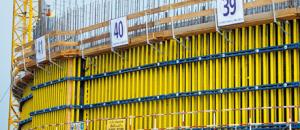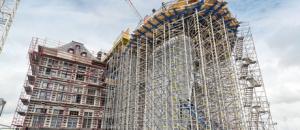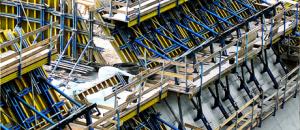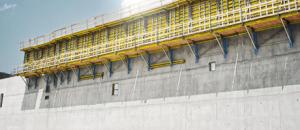Mumbai, the biggest metropolis on the Indian subcontinent, has an efficient but chronically overcrowded network of inner-city trains. The city is thus investing heavily in expanding its transportation infrastructure. Doka assisted the work on a new metro line with an ingenious formwork system for a 175 m long extradosed bridge that was built across a flyover on the Western Express Highway. The special challenge here: work on the two nearly 40 m tall piers and Y-shaped pylons could only take place at night, and with no disruption to traffic.
Press Contact
Impressions
Mumbai’s infrastructure is struggling to keep pace with the headlong growth in the city’s population and economy. To improve local mass-transit capacity and connect up new districts of the city, a new metro network is under construction. The Mumbai Metro Project was started in 2006 and is to be completed in three phases by 2021. Nine lines are planned, totalling 147 kilometres of new track. Phase I is currently being implemented, with the first line scheduled for completion by the end of 2012.
A key project on the elevated Metro Line 1 between Versova and Ghatkopar is a 175 m long extradosed bridge in the suburb of Andheri; built by SEW Infrastructure Ltd., the structure crosses a flyover on the Western Express Highway. An extradosed bridge combines the structural behaviour of a cable-stayed bridge with that of a girder bridge. The cable-stays act like tensioning tendons located outside the body of the carriageway deck. They carry the superstructure from a relatively low pylon, pre-stressing it at the same time.
Nishant Agarwal, Senior Planning Engineer at SEW Infrastructure Ltd., was very satisfied indeed with the formwork concept provided by Doka: “Being tailor-made specially for us, these solutions gave us maximum benefit in terms of safety, efficiency and cost savings. Our decision to field Dam formwork D22 in conjunction with Large-area formwork Top 50 gave us the ideal equipment combination for constructing the continuously tapering structure while complying with the tough specifications regarding the concrete finish and the safety rules. The round-the-clock support we got from the Doka team, and the fast site-erection times, both made a big contribution to the success of this build.”
A key project on the elevated Metro Line 1 between Versova and Ghatkopar is a 175 m long extradosed bridge in the suburb of Andheri; built by SEW Infrastructure Ltd., the structure crosses a flyover on the Western Express Highway. An extradosed bridge combines the structural behaviour of a cable-stayed bridge with that of a girder bridge. The cable-stays act like tensioning tendons located outside the body of the carriageway deck. They carry the superstructure from a relatively low pylon, pre-stressing it at the same time.
Made-to-measure formwork concept
Doka developed a custom formwork concept for building the two piers and Y-shaped pylons. The contractors required a climbing solution so as to avoid any disruption whatever to vehicle traffic on the elevated Western Express Highway or the major crossroads beneath it, in any stage of the work. Work was only allowed to take place at night. The 19 m tall pier shafts were formed using crane-jumped Climbing formwork MF240 plus Large-area formwork Top 50 – a system combination that makes for very safe, fast forming operations. Climbing formwork MF240 permits controlled, regular working cycles on all tall structures. Despite being so easy to erect, it is suitable for tackling many different requirements and stands out for its excellent adaptability to any geometry. The 2.40 m wide working platform also offers plenty of space for safe working. The casting sections were max. 3.80 m in height, with a clear width of 3.50 m, and were poured in a 10-day cycle. A second set of formwork was used for other, diam. 2 m piers. The pier-heads were divided into two casting segments which were formed using Large-area formwork Top 50 and the Load-bearing tower Staxo 100. With its robust steel frames, this latter system is designed for great shoring-heights and high loads. Staxo 100 was also used to create temporary workspaces and as additional shoring for the carriageway trough (with Top 50 superstructure and formwork).High-performing dam formwork
On the formwork for the 20 m tall pylon legs, which have an outward inclination of around eleven percent, Doka scored with its high-performing Dam formwork D22. The high load capacity of this system means that only a small number of cantilever brackets are needed, which made a critical contribution towards fast construction progress. The D22 adapted perfectly to the constantly varying shape of the structure, while the Dokaplex 18 formwork sheets ensured a superior surface finish. All subsequent operations were performed from working platforms on four different levels. The Formwork Experts used the tapered holes in the D22 dam formwork to hang the working platforms from – an extremely economical solution. The cycle time during construction of the pylon legs was seven days per cycle.Nishant Agarwal, Senior Planning Engineer at SEW Infrastructure Ltd., was very satisfied indeed with the formwork concept provided by Doka: “Being tailor-made specially for us, these solutions gave us maximum benefit in terms of safety, efficiency and cost savings. Our decision to field Dam formwork D22 in conjunction with Large-area formwork Top 50 gave us the ideal equipment combination for constructing the continuously tapering structure while complying with the tough specifications regarding the concrete finish and the safety rules. The round-the-clock support we got from the Doka team, and the fast site-erection times, both made a big contribution to the success of this build.”
This could also be of interest for you:
Do you have any questions on the article? Get in touch with us!







